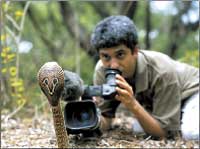
Sitting under the charcoal sketch of the awe-inspiring visage of an Indian Tiger, Chennai-based wildlife filmmaker, Shekar Dattatri, talks about why he continues to attribute the epithet, ‘struggling filmmaker’, to himself. “The primary income in wildlife filmmaking is job satisfaction. There is no control over the subject, there are no guarantees and trends change constantly. If there is money, it’s a bonus.” I note the ‘if’ in favour of the ‘when’ and wonder, how someone who has won numerous national and international awards for his films, and was more recently, the recipient of an Associate Laureate Award under the Rolex Awards for Enterprise, can call himself a ‘struggling filmmaker’!
However, this much is evident – meeting Shekar is like being swept away in a deluge of anecdotes and sound-bytes. He speaks of his early introduction to the wild when his sister gifted him a book by Gerald Durrell and his discovery that one doesn’t have to go into the jungles to watch animals, the ones in the backyard were just as interesting. At age 13, he remembers cockily asking Rom Whitaker if he could join the Madras Snake Park as a volunteer as he already knew how to handle snakes. Rom agreed with the usual word of caution, and Shekar began to spend his weekends there, gradually progressing to accompanying snake-catching Irula tribals on trips. When he attended school during the week, he sat in the last bench, immersed in books on wildlife.
Shekar then began going further afield on surveys that helped him get attuned to the jungle and, along with the knowledge gleaned from extensive reading, he began the long process that led to becoming a wildlife filmmaker. This quest for knowledge of the natural world is evident in every anecdote that Shekar narrates, be it about crabs grinding sand pellets on the beach at Point Calimere or a tiger trailing a mother rhino and her calf at Kaziranga.
Shekar reminisces about the time he was making a film for National Geographic Channel, on the Indian Cobra. Along with a couple of colleagues, he waited 30 whole days and nights with 6 pregnant cobras, to film them laying eggs. In his bedroom. He recounts the experience, “One night, at 2 a.m., I happened to wake up, and found one of the cobras (finally!) in the process of laying eggs. My colleague, who was supposed to keep watch, had succumbed to fatigue and fallen asleep. So, I gently transferred the cobra to the simulated rat-burrow set, and started filming. The eggs were translucent when laid, and the embryo and blood vessels were visible. But within a minute, blobs of a white substance appeared on the egg-shell as though shot from within, and made it totally opaque! That’s the joy of wildlife filmmaking – you get to see things that a lot of other people miss!”
Shekar remembers one incident when he was filming on the banks of the Kabini River. “We had been observing a blind female elephant and her baby elephant who always stayed separate from the herd. One day, we noticed a very dark adult female elephant, standing with them. As the new elephant was unaccustomed to our presence, we didn’t get closer. For some reason, possibly to adjust the lens, I moved slightly. This action caught the eye of the new elephant, and she charged at us without warning! There was no time to turn the vehicle around, so we reversed for almost 100 metres, before she finally gave up and retreated.”
Shekar’s commitment to conservation and environmental awareness, is evident from the gamut of subjects he has chosen to make films on – from snakes and rats to tigers and olive ridley turtles. He believes that films can go beyond the purpose of sensitising the audience to environmental issues. In the right circumstances, they can draw the attention of policy makers and help bring about solutions.
One audience that Shekar would like to focus on, is children – “Children are like sponges – they soak up so much information and are yet to become cynical. Given the right information, they’ll grow up to be a generation that’s much more proactive and conscious of these issues. As part of the Rolex Award, one of my objectives is to build a body of work with short films on different issues which could help equip school libraries, and be played during environmental science classes.”, he says.
Which brings us to the general impression of wildlife filmmaking being a very macho vocation, with images of striking cobras and attacking leopards coming to mind. “Yes, there’s adventure around every corner, but if you ask me, I feel much safer amidst wildlife in a jungle – it’s cities and people that I’m wary of!” he says.


